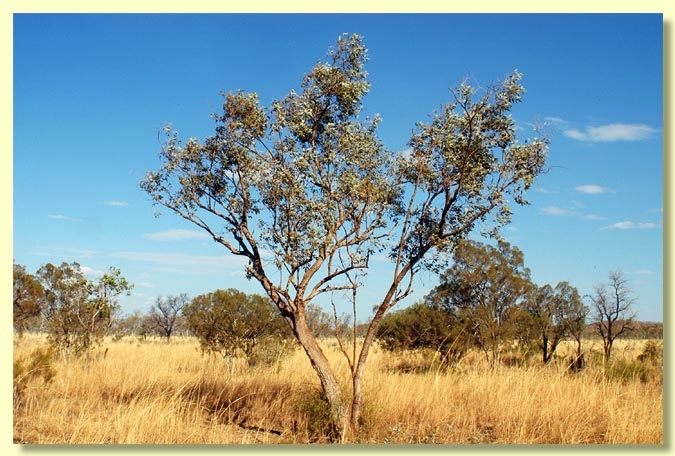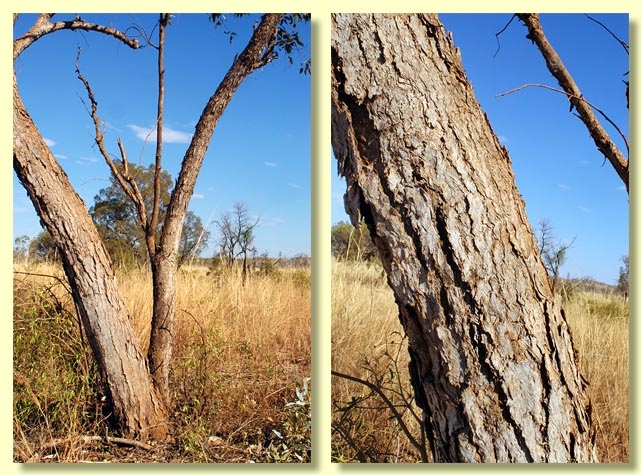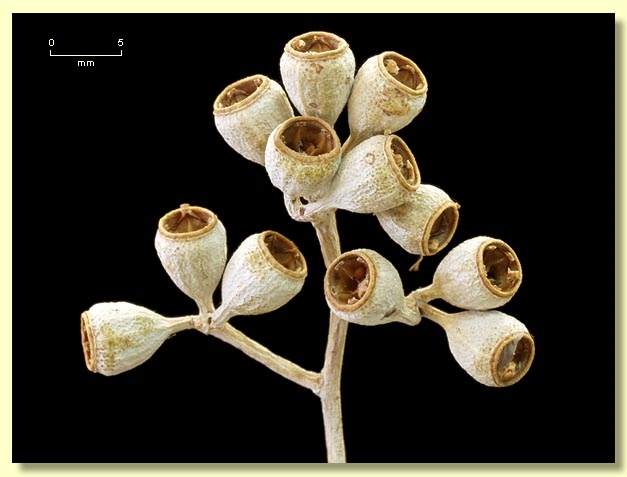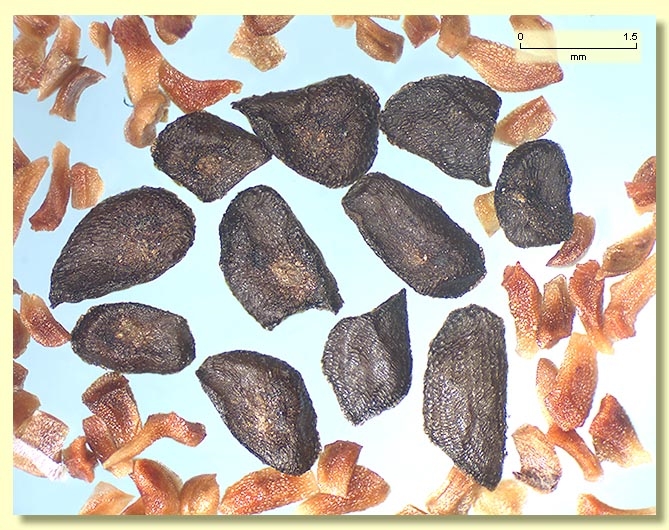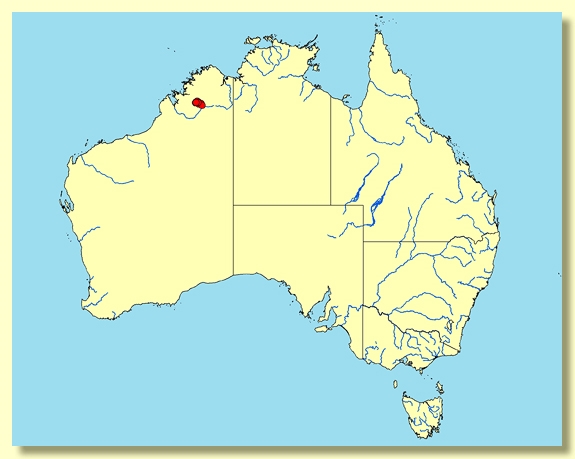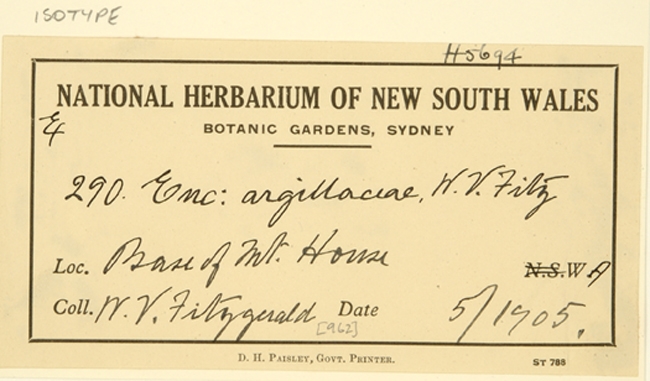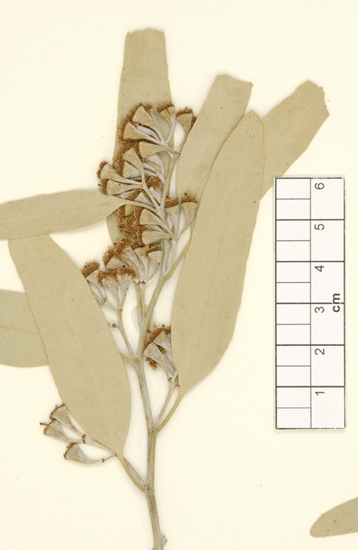Mount House box
Euclid - Online edition
Eucalyptus argillacea
Eucalyptus | Symphyomyrtus | Adnataria | Apicales | Aquilonares | Protrusae
Straggly tree to 5 m tall. Forming a lignotuber.
Bark grey-brown to bleached grey, box-type extending to small limbs, on some older plants appearing ± tessellated.
Branchlets lack oil glands in the pith; glaucous.
Juvenile growth (coppice or field seedlings to 50 cm): not seen.
Adult leaves alternate, petioles 0.8–2.3 cm long; blade elliptical to lanceolate or ovate, 5–14 cm long, 1.2–3.5(4.5) cm wide, base tapering to petiole, margin entire, apex pointed or rounded, concolorous, dull, glaucous weathering to grey-green, side-veins at greater than 45° to midrib, reticulation dense to very dense, intramarginal vein present but close to margin, oil glands scattered, intersectional.
Inflorescence terminal compound, peduncles rounded to angular, slender, 0.3–1.5 cm long, buds 7 per umbel, pedicellate (pedicels 0.2–0.5 cm long). Mature buds pyriform to obovoid or fusiform, 0.6–1 cm long, 0.4–0.6 cm wide, glaucous, scar present (outer operculum shed early), operculum conical to shortly beaked, stamens irregularly flexed, all fertile, anthers adnate, basifixed, cuboid, dehiscing by lateral slits or pores, style straight and long, stigma blunt, locules 4 or 5, the placentae each with 4 vertical ovule rows. Flowers creamy white.
Fruit pedicellate (pedicels 0.2–0.5 cm long), usually obconical, longer than wide, 0.6–1 cm long, 0.4–0.6 cm wide, glaucous, disc descending vertically but often obscured by persistent staminophore, valves 4 or 5, at rim level or enclosed.
Seeds blackish brown, 1.8–3 mm long, flattened-ovoid, dorsal surface shallowly reticulate, hilum ventral.
Cultivated seedlings (measured at ca node 10): cotyledons reniform, small; stems square or rounded in cross-section, slightly glaucous or non-glaucous; leaves always petiolate, opposite for 6 to 10 nodes then alternate, 5–10.5 cm long, 2–3.6 cm wide, base tapering to petiole, margin usually entire, rarely subcrenulate, apex pointed, grey-green to slightly glaucous, concolorous.
Flowering has been recorded in April.
A small tree of poor form endemic to Western Australia, of restricted distribution in the Mount House area of the central Kimberley region where it occurs on red loamy grassy plains or as a component of low open savannah woodland with E. tectifica. Eucalyptus argillacea is fully rough box-barked and has a glaucous crown of elliptical to lanceolate or ovate leaves and obconical fruit longer than wide with the valves at about rim level when dehisced.
Within its narrow natural range the glaucous E. argillacea will probably only be confused with E. tectifica, another fully box-barked species but which is non-glaucous and has thin-walled cupular fruit and green leaves. Another blue- to glaucous-leaved box-barked species growing further east in the Kimberley region, E. tephrodes, has more robust cupular to barrel-shaped fruit and prefers more stony soils. Other closely related box species occurring in this region are less likely to be confused. The fully rough-barked coolabah, E. microtheca, has more thin-walled ± isodiametric obconical fruit slightly contracted at the top and is restricted to seasonally inundated floodplains and stream banks. The glossy green-leaved fully rough-barked box E. chlorophylla has obconical fruit that are longer than wide but never glaucous; it prefers loamy plains and is widespread from near Fitzroy Crossing east to the Gulf of Carpentaria at the drier southern fringe of the monsoonal belt. Another poorly known box-barked species, E. limitaris, which has dull green leaves and more robust non-glaucous buds and fruit, is more closely related to E. tephrodes than it is to E. argillacea, and occurs eastwards from near Fitzroy Crossing in the southern Kimberley region into the western Northern Territory, occurring along levees of seasonal streams.
In the classification of Brooker (2000) Eucalyptus argillacea is placed in Eucalyptus subgenus Symphyomyrtus section Adnataria (the boxes) because the buds have two opercula, ovules are in four rows, seeds are flattened-ovoid, cotyledons reniform, and anthers are rigid on the staminal filaments. Within section Adnataria, E. argillacea belongs to a subgroup of box species with tropical distribution, series Aquilonares subseries Protrusae, having inflorescences terminal on the branchlets, adult leaves very densely reticulate and fruit that are thin-walled and have valves more or less at rim level when dehisced.
Previously any box-barked small tree with any glaucescence and with small buds and fruit was assigned to E. argillacea but recent research has shown it to have a distinctive morphology and a restricted distribution (see Blake 1953, Brooker & Kleinig 1995, Hill 2000).
Eucalyptus argillacea: Latin argilla, clay, referring to the soil at the type locality for this species.

